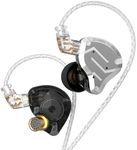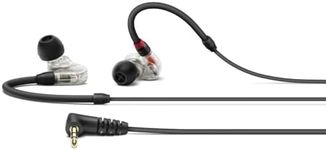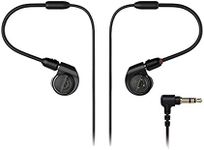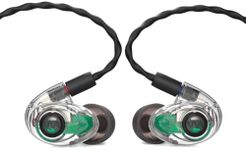Buying Guide for the Best In Ear Monitors For Musicians
In-ear monitors (IEMs) are essential for musicians who need to hear themselves and other instruments clearly during performances or recording sessions. Choosing the right IEMs can significantly enhance your performance by providing accurate sound reproduction and noise isolation. When selecting IEMs, consider the following key specifications to ensure you get the best fit for your needs.Driver TypeThe driver is the component that converts electrical signals into sound. There are different types of drivers, such as dynamic, balanced armature, and hybrid. Dynamic drivers are known for their robust bass response and durability, making them suitable for genres with heavy bass. Balanced armature drivers offer more detailed and accurate sound, ideal for classical or acoustic music. Hybrid drivers combine both types to provide a balanced sound profile. Choose the driver type based on the genre of music you play and your sound preference.
Frequency ResponseFrequency response refers to the range of frequencies that the IEMs can reproduce, typically measured in Hertz (Hz). A wider frequency response range means the IEMs can produce both very low and very high sounds. For example, a range of 20Hz to 20kHz covers the full spectrum of human hearing. If you play music with a lot of bass, look for IEMs with a good low-end response. For genres that require clarity in the mid and high frequencies, ensure the IEMs have a strong response in those ranges.
ImpedanceImpedance is the resistance the IEMs provide to the electrical signal, measured in ohms. Lower impedance (16-32 ohms) IEMs are easier to drive and can be used with portable devices like smartphones without requiring an amplifier. Higher impedance (above 32 ohms) IEMs may offer better sound quality but often need an external amplifier to reach their full potential. Choose based on your equipment; if you use professional audio gear, higher impedance might be suitable, but for casual use, lower impedance is more practical.
Noise IsolationNoise isolation refers to the IEMs' ability to block out external sounds, allowing you to focus on your music. This is achieved through the design and fit of the ear tips. Good noise isolation is crucial for live performances to prevent stage noise from interfering with your monitoring. Look for IEMs with multiple ear tip sizes and materials (foam, silicone) to ensure a snug fit. If you perform in loud environments, prioritize IEMs with excellent noise isolation capabilities.
Comfort and FitComfort and fit are essential for long performances or recording sessions. IEMs should fit securely in your ears without causing discomfort. Many IEMs come with various ear tip sizes and shapes to accommodate different ear canals. Custom-molded IEMs offer the best fit and comfort but are more expensive. Consider how long you'll be wearing the IEMs and choose a pair that feels comfortable and stays in place during movement.
DurabilityDurability is important, especially for musicians who perform regularly. IEMs should be built to withstand the rigors of frequent use and transportation. Look for IEMs with reinforced cables, sturdy housings, and sweat-resistant materials. If you travel often or perform in various environments, prioritize IEMs known for their durability to ensure they last longer.
Cable TypeThe type of cable can affect both the durability and convenience of your IEMs. Detachable cables are a great feature as they can be replaced if damaged, extending the life of your IEMs. Some cables are designed to reduce tangling and microphonics (unwanted noise from cable movement). Consider your usage scenario; if you move around a lot on stage, a durable, tangle-free cable might be beneficial.













